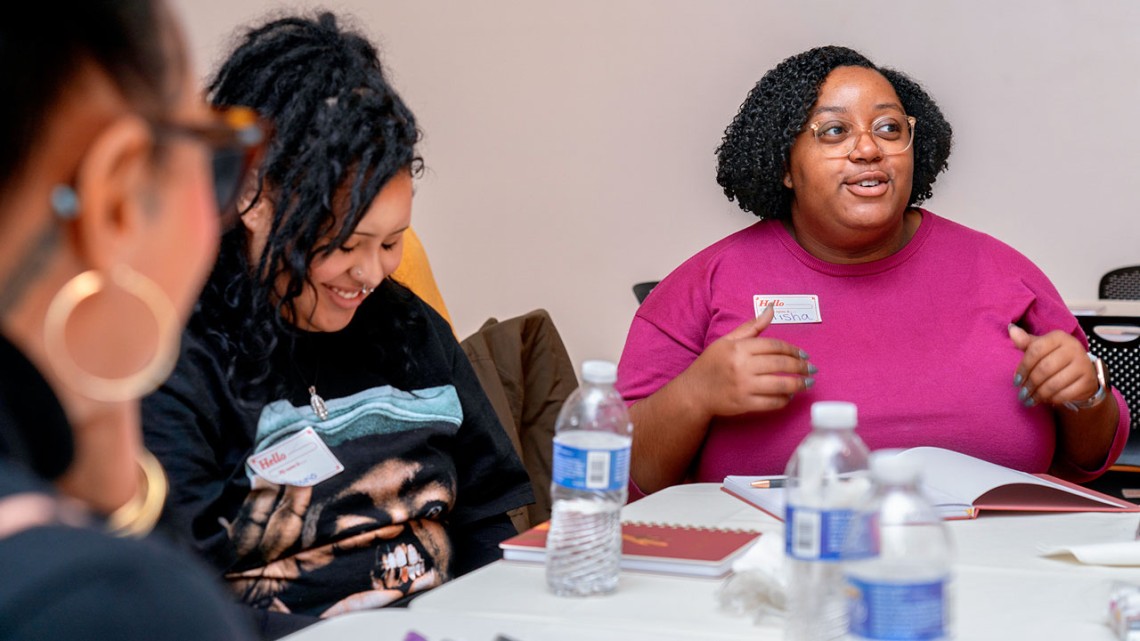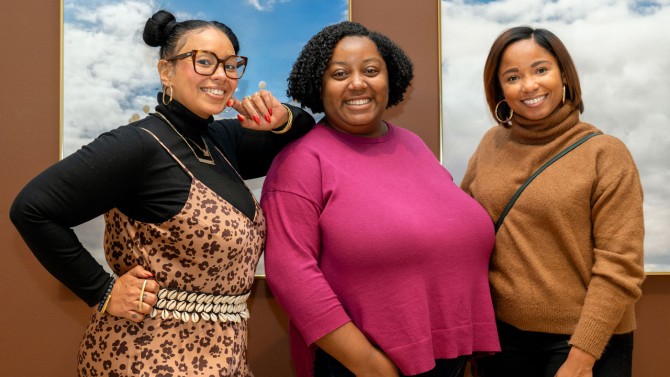
Misha Inniss-Thompson ’16, assistant professor of psychology and co-founder of the working group “Collectively Envisioning Black Girl Futures,” participates in a workshop at the Herbert F. Johnson Museum of Art on Nov. 11.
Exploring girlhoods, Black scholars connect, imagine and heal
By Caitlin Hayes, Cornell Chronicle
Jamila Walida Simon, M.S. ’10, grew up in a time and place where children were expected to be largely seen and not heard; as an adult, she wanted to correct that, providing space for Black girls to express themselves, their thoughts and feelings, their struggles and aspirations.
Now, as part of a working group that spurs and supports the self-reflection of Black women who work with Black girls, Simon has found that space for herself.
“Whatever we’re feeling and believing about ourselves bleeds down into our work,” said Simon, a doctoral candidate in global development who mentors Black girls in Tompkins County and serves as associate director of innovation in youth programming at the Bronfenbrenner Center for Translational Research in the College of Human Ecology and the NYS 4-H civic engagement specialist with Cornell Cooperative Extension. “The ongoing self-reflection is incredibly vital and important. After having these experiences, I think about my own inner Black girl and the ways I bring her into these spaces. I think about reeducating her but also bringing that Black-girl joy into the work I do as well.”
Now in its third cycle of funding from the Central New York Humanities Corridor, the working group, “Collectively Envisioning Black Girl Futures,” was founded in fall 2022 by Misha Inniss-Thompson ‘16, assistant professor of psychology in the College of Human Ecology, and Courtney Mauldin, assistant professor of educational leadership at Syracuse University. Their mission is to bring Black female scholars, activists, community workers and educators together to reflect on their childhoods and find community – all in order to better serve the Black girls with whom they work.
Most recently, they joined Ithaca-born photographer Nydia Blas to explore her exhibition, open through Jan. 7 at the Herbert F. Johnson Museum of Art, which celebrates and exalts, even mythologizes, moments in the lives of Black families. Blas led the group in a discussion of how family, history and home shape participants’ understanding of Black girlhood.
“We want to offer a space for Black women who work with Black girls to really dig into their own journeys,” said Inniss-Thompson, who has organized and studied the impact of programming for Black girls in Ithaca and Nashville, Tennessee, and whose research broadly examines how families, communities and schools shape Black girls’ mental health and wellness.
“Personally, co-creating this working group has made me a lot more open and honest about the wide array of what Black girlhoods look like and a lot more empathetic,” Inniss-Thompson said. “And I’m prioritizing: What does it look like for Black girls to be unapologetically themselves? What would that have meant for me when I was a girl?”
With more than 25 participants from Cornell and Syracuse universities and more than 30 additional scholars and community workers from upstate New York and beyond, the group uses art as a springboard for reflection; they read books of poetry, memoirs and academic texts centered on Black girlhood, and attend exhibitions, often meeting with the authors and artists for interactive sessions. With scholar and poet DaMaris B. Hill, they reflected on poetry about Black girlhood, for example; with author reelaviolette botts-ward, they wrote letters to their girlhood selves.
Participants describe the workshops and conversations as life-giving, soul-feeding and healing. While diverse in their backgrounds, many faced similar childhood hardships: lacking representation of Black girls and women in the media and professional spaces; and experiencing the isolation of being the only Black girl in majority-white spaces.
“You’re having to sit with all of the feelings,” Mauldin said. “The spaces we share with our working group are very vulnerable and open and often emotional, and in good ways. But I think healing. It’s been that for me.”
“I’m a lot nicer to myself now. I’m learning that the same grace and kindness I give to Black girls I should also be giving to myself,” said Aishat Sadiq, a doctoral student in psychology. “We’re able to mourn the sadness that occurred in our childhoods and then move past it.”
The working group is changing the trajectory of participants’ research and work, often inviting them to more fully integrate their identities as Black women and activists with their identities as scholars. Mauldin said the group has helped her find a home in work that is both scholarly and community-oriented; Inniss-Thompson said she’s found a greater sense of agency and imagination in the classroom.
Sadiq’s participation in the group has inspired new directions in her research – she wants to study the impact of safe, community-building spaces for Black girls and to incorporate more mixed methods like narratives in her data collection. She said the group has reminded her of her own humanity and that of her research subjects’.
“It’s really helped me recognize that even in the quantitative research world, I bring my whole identity, and that helps me connect with what I’m doing with my participants,” she said.
The group provides a professional network for Black women doing similar work, as well as the same sense of personal belonging they want to provide for Black girls.
“We hold space for one another in that shared identity,” Simon said. “There’s a sense of openness, that whatever lands in our spaces is meant to be there and won’t be judged.”
Ultimately, the goal of looking to their own pasts is to then approach their work with Black girls with a better understanding of what they need, to provide them with the space and support to see their futures as full of possibility.
“We have the potential to impact the education community at large,” said Mauldin, who is co-founder of The Breedlove Readers book club for middle and high school-aged Black girls in the Central New York Region. “We have these women in leadership roles who are interfacing with Black girls in a variety of educational spaces. The critical and personal reflection allows us to go into these spaces and see the girls differently, and to be more tender and not perpetuate harms.”
Simon said the girls she works with in the Ithaca community have already benefited.
“I’ve been thinking about how we create a sense of welcome and curiosity and belonging, and asking folks what that looks like for them,” Simon said. “When appropriate, I’ve even brought some of the dialogues we’ve had in the group to the teams I’m working with, or some of the materials, and it’s really been beautiful.”
The group’s latest event at the Johnson Museum was the first where Black girls were invited – something the group plans to do more of in the coming year.
Rochele Royster, assistant professor of art therapy at Syracuse, brought her 11-year old daughter, who was attracted to the stories behind Blas’ photographs as well as the archival photos included in the exhibition. At one point, Royster and her daughter stood in front of a photograph of a Black mother and daughter, the latter in her high school graduation gown. Royster said it was like looking into the future, together.
“There’s something about being able to see yourself represented in a positive light and being in a safe space where you can be yourself without judgment, where people understand what you’re talking about – it’s an important part of identity and belonging,” Royster said. “And it just feels good.”
Media Contact
Get Cornell news delivered right to your inbox.
Subscribe


